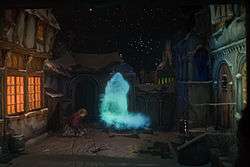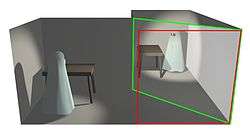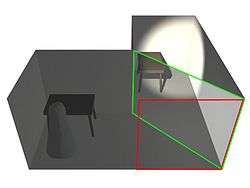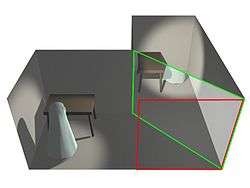Pepper's ghost
Pepper's ghost is an illusion technique used in theatre, amusement parks, museums, television, and concerts. It is named after John Henry Pepper (1821–1900), a scientist who popularized the effect in a famed demonstration in 1862.[1] It has a long history, dating back into the 19th century, and remains widely performed today. Notable examples of the illusion are the Girl-to-Gorilla trick found in old carnival sideshows and the appearance of "ghosts" at the Haunted Mansion at Disneyland. Teleprompters are a modern implementation of Pepper's ghost. Examples of concert illusions based on Pepper's ghost are the appearance of Tupac Shakur onstage with Dr. Dre and Snoop Dogg at the 2012 Coachella Music and Arts Festival and Michael Jackson at the 2014 Billboard Music Awards.
Effect
An audience views a stage or room with various objects in it. On command, ghostly objects appear to fade in or out of existence in the room, or objects in the room magically transform into different objects.
Technique
The basic trick involves a stage that is specially arranged into two rooms, one that people can see into or the stage as a whole, and a second that is hidden to the side, the "blue room". A plate of glass (or Plexiglas or plastic film) is placed somewhere in the main room at an angle that reflects the view of the blue room towards the audience. Generally this is arranged with the blue room to one side of the stage, and the plate on the stage rotated around its vertical axis at 45 degrees.[2] Care must be taken to make the glass as invisible as possible, normally hiding the lower edge in patterning on the floor and ensuring lights do not reflect off it.
When the lights are bright in the main room and dark in the blue room, the reflected image cannot be seen. When the lighting in the blue room is increased, often with the main room lights dimming to make the effect more pronounced, the reflection becomes visible and the objects within the blue room seem to appear in thin air. A common variation uses two blue rooms, one behind the glass and one to the side, which can be switched visible or invisible by alternating the lighting.[2]
The hidden room may be an identical mirror-image of the main room, so that its reflected image matches the main rooms; this approach is useful in making objects seem to appear or disappear. This illusion can also be used to make one object or person reflected in the mirror appear to morph into another behind the glass (or vice versa). This is the principle behind the Girl-to-Gorilla trick found in old carnival sideshows. The hidden room may instead be painted black, with only light-colored objects in it. In this case when light is cast on the room, only the light objects reflect the light and appear as ghostly translucent images superimposed in the visible room. This can be used to make objects appear to float in space.
History
Giambattista della Porta
Giambattista della Porta was a 16th-century Neapolitan scientist and scholar who is credited with a number of scientific innovations, including the camera obscura. His 1584 work Magia Naturalis (Natural Magic) includes a description of an illusion, titled "How we may see in a Chamber things that are not" that is the first known description of the Pepper's ghost effect.[3]
Porta's description, from the 1658 English language translation, is as follows.
Let there be a chamber wherein no other light comes, unless by the door or window where the spectator looks in. Let the whole window or part of it be of glass, as we used to do to keep out the cold. But let one part be polished, that there may be a Looking-glass on bothe sides, whence the spectator must look in. For the rest do nothing. Let pictures be set over against this window, marble statues and suchlike. For what is without will seem to be within, and what is behind the spectator's back, he will think to be in the middle of the house, as far from the glass inward, as they stand from it outwardly, and clearly and certainly, that he will think he sees nothing but truth. But lest the skill should be known, let the part be made so where the ornament is, that the spectator may not see it, as above his head, that a pavement may come between above his head. And if an ingenious man do this, it is impossible that he should suppose that he is deceived.[4]
John Pepper and Henry Dircks
The Royal Polytechnic Institute London was a permanent science-related institution, first opened in 1838. With a degree in chemistry, John Henry Pepper joined the institution as a lecturer in 1848. The Polytechnic awarded him the title of Professor. In 1854, he became the director and sole lessee of the Royal Polytechnic.[1]
In 1862, inventor Henry Dircks developed the Dircksian Phantasmagoria, his version of the long-established phantasmagoria performances.[5] This technique was used to make a ghost appear on-stage. He tried unsuccessfully to sell his idea to theatres. It required that theaters be completely rebuilt to support the effect, which they found too costly to consider. Later in the year, Dircks set up a booth at the Royal Polytechnic, where it was seen by John Pepper.[1]
Pepper realized that the method could be modified to make it easy to incorporate into existing theatres. Pepper first showed the effect during a scene of Charles Dickens's The Haunted Man, to great success. Pepper's implementation of the effect tied his name to it permanently. Dircks eventually signed over to Pepper all financial rights in their joint patent. Though Pepper tried many times to give credit to Dircks, the title "Pepper's ghost" endured.[6]
The relationship between Dircks and Pepper was summarised in an 1863 article from Spectator:
"This admirable ghost is the offspring of two fathers, of a learned member of the Society of Civil Engineers, Henry Dircks, Esq., and of Professor Pepper, of the Polytechnic. To Mr. Dircks belongs the honour of having invented him, or as the disciples of Hegel would express it, evolved him from out of the depths of his own consciousness; and Professor Pepper has the merit of having improved him considerably, fitting him for the intercourse of mundane society, and even educating him for the stage."[7]
Modern examples
Amusement parks
The world's largest implementation of this illusion can be found at the Haunted Mansion and Phantom Manor attractions at several Walt Disney Parks and Resorts. There, a 90-foot (27 m)-long scene features multiple Pepper's ghost effects, brought together in one scene. Guests travel along an elevated mezzanine, looking through a 30-foot (9.1 m)-tall pane of glass into an empty ballroom. Animatronic ghosts move in hidden black rooms beneath and above the mezzanine. The Pepper's Ghost effect is also used at The Twilight Zone Tower of Terror.
The walk-through attraction Turbidite Manor in Nashville, Tennessee, employs variations of the classic technique, enabling guests to see various spirits that also interact with the physical environment, viewable at a much closer proximity. The House at Haunted Hill, a Halloween attraction in Woodland Hills, California, employs a similar variation in its front window to display characters from its storyline.

An example that combines the Pepper's ghost effect with a live actor and film projection can be seen in the Mystery Lodge exhibit at the Knott's Berry Farm theme park in Buena Park, California, and the Ghosts of the Library exhibit at the Abraham Lincoln Presidential Library and Museum in Springfield, Illinois, as well as the depiction of Maori legends called A Millennium Ago at the Museum of Wellington City & Sea in New Zealand.
The Hogwarts Express attraction at Universal Studios Florida uses the Pepper's ghost effect, such that guests entering "Platform 9 3/4" seem to disappear into a brick wall when viewed from those further behind in the queue.
Museums
Museums increasingly use Pepper's ghost exhibits to create attractions that appeal to visitors. In the mid-70s James Gardener designed the Changing Office installation in the London Science Museum, consisting of a 1970s-style office that transforms into an 1870s-style office as the audience watches. It was designed and built by Will Wilson and Simon Beer of Integrated Circles. Another particularly intricate Pepper's ghost display is the Eight Stage Ghost built for the British Telecom Showcase Exhibition in London in 1978. This display follows the history of electronics in a number of discrete transitions.

More modern examples of Pepper's ghost effects can be found in various museums in the United Kingdom and Europe. Examples of these in the United Kingdom are the ghost of Annie McLeod at the New Lanark World Heritage Site, the ghost of John McEnroe at the Wimbledon Lawn Tennis Museum, which reopened in new premises in 2006, and one of Sir Alex Ferguson, which opened at the Manchester United Museum in 2007.[8] Other examples include the ghost of Sarah (who picks up a candle and walks through the wall) and also the ghost of the Eighth Duke at Blenheim Palace.
In October 2008 a life-sized Pepper's ghost of Shane Warne was opened at the National Sports Museum in Melbourne, Australia.[9] The effect is also used at the Dickens World attraction at Chatham Maritime, Kent, United Kingdom. Both the York Dungeon and the Edinburgh Dungeon use the effect in the context of their 'Ghosts' shows.
Another example can be found at Our Planet Centre in Castries, St Lucia, which opened in May 2011, where a life-size Prince Charles and Governor general of the island appear on stage talking about climate change.[10]
The South African Jewish Museum in Cape Town uses elaborate Pepper's ghost video technology in their permanent exhibit. The Artist Group PXNG.LI has exhibited the evolutionary processes in a Pepper's ghost box at the Natural Science Museum in Karlsruhe, Germany.
Television, film, and video
Teleprompters are a modern implementation of Pepper's ghost used by the television industry. They reflect a speech or script and are commonly used for live broadcasts such as news programmes.
In the episode of The Magic School Bus that deals with light, "Gets a Bright Idea", Arnold's mischievous cousin Janet uses a Pepper's ghost illusion to convince the class a theater is haunted. It ends up helping the class learn more about how light and reflections behave.
On 1 June 2013, ITV broadcast Les Dawson: An Audience With That Never Was. The programme featured a Pepper's ghost projection of Les Dawson, presenting content for a 1993 edition of An Audience with... to be hosted by Dawson but unused due to his death two weeks before recording.[11]
In the 1990 movie Home Alone, the technique is used to show Harry with his head in flames, as result of a blow torch from a home invasion gone bad. CGI was not available at the time of filming.[12]
In the 2016 BBC Sherlock episode "The Abominable Bride", the pepper's ghost trick is used to show Emelia Ricolleti as a ghost in Sir Eustace Charmichael's house.
Several products have been designed using a clear plastic pyramid and a smartphone screen to generate the illusion of a 3D object.[13]
Concerts
An illusion based on Pepper's ghost involving projected images has been featured at music concerts (often erroneously marketed as "holographic");[14] Such setups typically involve custom projection media server software and specialized stretched films.[15]
At the 2006 Grammy Awards, the Pepper's ghost technique was used to project Madonna with the virtual members of the band Gorillaz onto the stage in a "live" performance. This type of system consists of a projector (usually DLP) or LED screen, with a resolution of 1280×1024 or higher and brightness of at least 5,000 lumens, a high-definition video player, a stretched film between the audience and the acting area, a 3D set/drawing that encloses three sides, plus lighting, audio, and show control.[16]
During Dr. Dre and Snoop Dogg's performance at the 2012 Coachella Valley Music and Arts Festival, a projection of deceased rapper Tupac Shakur appeared and performed "Hail Mary" and "2 of Amerikaz Most Wanted".[14][17][18] The use of this approach was repeated in 2013 at west coast Rock the Bells dates, featuring projections of Eazy-E and Ol' Dirty Bastard.
On 18 May 2014, during the Billboard Music Awards, an illusion of deceased pop star Michael Jackson, other dancers, and the entire stage set was projected onto the stage for a performance of the song "Slave to the Rhythm" from the posthumous Xscape album.[19][20]
In the Eurovision Song Contest 2016, IVAN from Belarus used an illusion during the performance.
Political speech world record
The Guinness World Record for most simultaneous shows of the Pepper's ghost illusion is now held by Raj Kasu Reddy and Mani Shankar of NChant 3D, which telecast, live, a 55-minute speech by Narendra Modi, Chief Minister of Gujarat, to 53 locations across Gujarat on 10 December 2012 during the assembly elections.[21][22][23] Narendra Modi broke the record again in April 2014, when he appeared live at 88 locations across India.[24]
See also
Notes
- 1 2 3 "Timeline for the history of the University of Westminster". University of Westminster. Archived from the original on 16 May 2006. Retrieved 28 August 2009.
- 1 2 Nickell, Joe (2005). Secrets of the Sideshows. University Press of Kentucky. p. 291. ISBN 9780813123585.
- ↑ "Pandora Archive". Pandora.nla.gov.au. 23 August 2006. Retrieved 14 January 2013.
- ↑ Porta p. 340
- ↑ ""Pepper's Ghost" Illusion". Ghost Theory.com. 12 October 2009. Retrieved 2 August 2015.
- ↑ Secord, J. A. (6 September 2002). "Quick and Magical Shaper of Science". Science. American Association for the Advancement of Science. Retrieved 15 August 2012.
- ↑ "The Patent Ghost". The Mercury. 21 July 1863. Retrieved 19 August 2012.
- ↑ "Meet Sir Alex – the hologram". Manchester United. 19 December 2007. Retrieved 2 August 2015.
- ↑ "Shane Warne – Cricket Found Me". National Sports Museum. Retrieved 2 August 2015.
- ↑ "Breakthrough environmental conservation visitor attraction opens". St Lucia Now.org. 20 June 2011. Retrieved 2 August 2015.
- ↑ Logan, Brian (31 May 2013). "Can a hologram Les Dawson tell 'em like he used to?". The Guardian. Retrieved 10 September 2013.
- ↑ http://www.slate.com/blogs/browbeat/2015/11/16/home_alone_hit_theaters_25_years_ago_here_s_how_they_filmed_its_bonkers.html
- ↑ http://www.gizmag.com/holus-interactive-holographic-tabletop-platform/37956/
- 1 2 "Holographic Projection". AV Concepts.com. Archived from the original on 18 May 2013. Retrieved 18 May 2013.
- ↑ Shein, Esther (July 2014). "Holographic Projection Systems Provide Eternal Life". Communications of the ACM. 57 (7): 19. doi:10.1145/2617664.
- ↑ Johnson, David. "Peppaz Ghost". Retrieved 18 April 2012.
- ↑ Jauregai, Andres (16 April 2012). "Tupac hologram: AV concepts brings late rapper to life at Coachella". The Huffington Post. Retrieved 4 September 2012.
- ↑ Anderson, Kyle. "Tupac lives (as a hologram) at Coachella!". Retrieved 4 September 2012.
- ↑ Giardina, Carolyn (21 May 2014). "Why Billboard Music Awards' Michael Jackson Can't Be Called a 'Hologram'". Retrieved 22 May 2014.
- ↑ Vincent, Peter (21 May 2014). "Michael Jackson not a hologram at Billboard Music Awards 2014". Retrieved 22 May 2014.
- ↑ "Modi's 3-D show enters Guinness Book". The Indian Express. 15 March 2013. Retrieved 15 August 2013.
- ↑ "Shri Modi's 3D Interaction enters Guinness World Records". Narendra Modi.in. 14 March 2013. Retrieved 15 August 2013.
- ↑ "Modi's 3D speeches during 2012 polls enter Guiness [sic] Book". Hindustan Times. 14 March 2013. Retrieved 15 August 2013.
- ↑ "India Elections: Narendra Modi leads with massive hologram campaign A". tvmix.com.
References
- Steinmeyer, Jim (1999). Discovering Invisibility. London.
- Steinmeyer, Jim (2003). Hiding the Elephant. New York: Carroll & Graf. ISBN 978-0-7867-1226-7.
- Steinmeyer, Jim (1999). The Science Behind the Ghost. London.
- Surrell, Jason (2003). The Haunted Mansion: From the Magic Kingdom to the Movies. New York: Disney Editions. ISBN 978-1-4231-1895-4.
- Porta, John Baptist (2003). Natural Magick. Sioux Falls, SD: NuVision Publications. ISBN 9781595472380.
External links
- J. A. Secord (6 September 2002). "Quick and Magical Shaper of Science". Science.
- Paul Burns (October 1999). "Chapter Ten: 1860–1869". The History of the Discovery of Cinematography.




